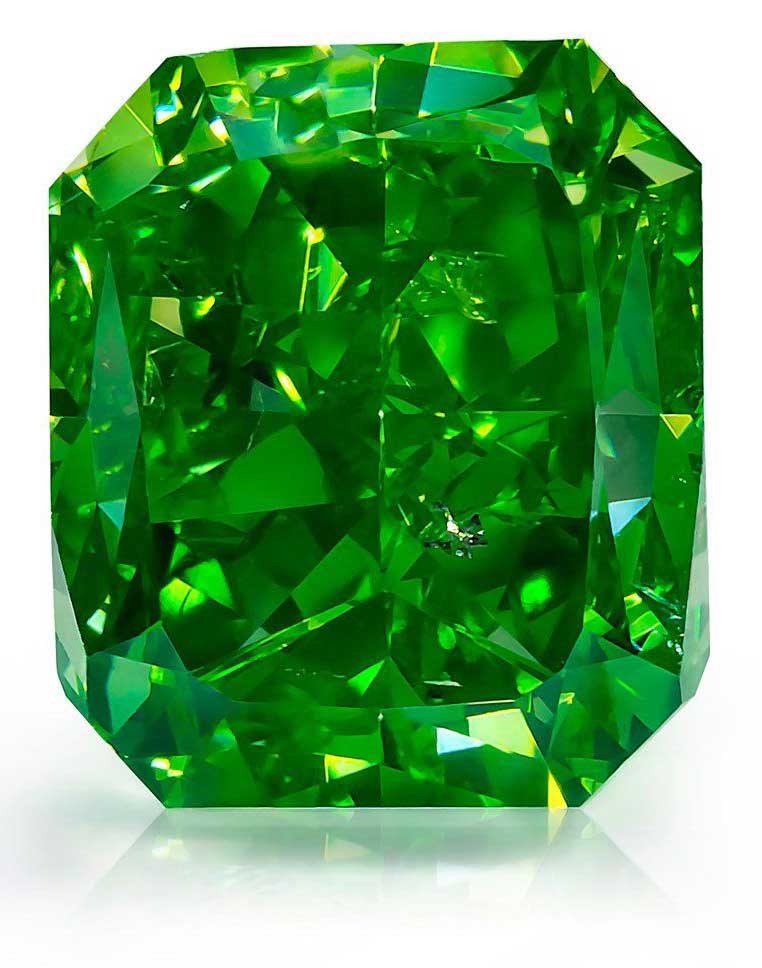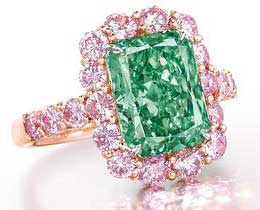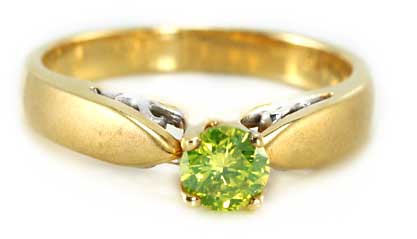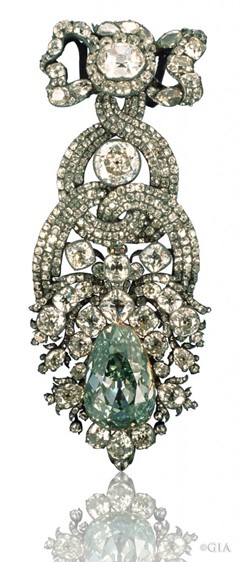Green Diamonds
 Have you ever seen a green diamond?
Have you ever seen a green diamond?
GIA’s gem-grading lab has seen a lot—perhaps too many? The lab recently sent letters to dealers who submitted green diamonds for grading between January and June of 2020. The lab wants to re-examine all those stones, at no charge, and perhaps issue new reports.
GIA didn’t reveal why, but people in the industry have a good guess, and we have some good advice for insurers.
Diamonds of saturated color, known as fancies, are extremely rare in nature, and green diamonds are among the rarest. When they come up at auction, their prices generally exceed expectation. The Aurora Green, a 5-carat VS2 Fancy Vivid Green, the most expensive green diamond sold at auction to date, went for $16.8 million, about $3.3 million per carat.
The Dresden Green, the largest natural green diamond found to date, weighs 40.70 carats. Its rough, before cutting and faceting, is estimated to have been more than 100 carats. Because of the way green diamonds are geologically formed, many have most of their color near the surface, so the gem’s color is lightened when the stone is faceted. The Dresden Green, however, is extraordinary because its color is evenly spread throughout the stone.
Of course, not all green diamonds are in that stratosphere for either value or quality.
GIA says that over the past decade its labs have examined well over 50,000 natural-color diamonds of “beautiful yet enigmatic” green hues. The greens vary from bluish greens to yellowish greens, and intensity goes from pale to deeply saturated.
Where does that color come from?
Color variations depend on radiation from certain elements in the area of the stone’s formation in the earth over millions of years. Or, that natural process is mimicked in a lab. And the difference is crucial.
The ability of radiation to change the color of diamond was discovered over a century ago. Early experiments produced colors that were subject to fading. And those stones might remain dangerously radioactive for years!
Those hurdles have been overcome.
Today’s technology allows for highly controlled color treatments, producing deeply saturated colors that are permanent and leaving the gems safe to wear.
Color-treated diamonds are vastly more affordable than the diamonds that acquired their rich color in the earth. It would seem to be a complete win. But the very existence of a lab-created alternative raises two important issues: disclosure of treatment and detection of treatment. And this is where the GIA’s call for the re-examination of green diamonds comes in.
DISCLOSURE of treatment
- Fancies—diamonds of deeply saturated color—are extremely rare in nature and very expensive. Lab-irradiation, however, is a low-cost treatment that can make diamonds of poor quality look like natural fancies to the unaided eye.
- Color treatment will change the diamond’s appearance, but it does not alter the quality of the stone. Flaws in the stone are still there and are visible under proper magnification.
- FTC Guidelines say it is deceptive to fail to disclose a treatment that affects the gem’s value.
- Color-treated diamonds are worth significantly less than untreated diamonds of similar appearance. This is especially important with fancies.
- If a lab-irradiated diamond is sold—and priced—as a natural fancy, the customer will be grossly overpaying on the purchase and, in the event of a claim, the insurer will be grossly overpaying a settlement.
- Color treatments can be done on lab-made diamonds as well as on mined (natural) diamonds. The diamond’s origin, as lab-made or natural, also requires disclosure.
DETECTION of treatment
NOTE: Most gem labs do not have the sophisticated equipment needed to make a definitive analysis of diamonds as to color treatments or as to whether a diamond is mined or made in a lab.
- GIA is considered the go-to lab for diamond grading, including detecting gem treatments and distinguishing between mined and lab-made stones.
- Color treatments usually leave evidence in the stone. GIA’s lab has the expertise and the latest technology for detecting treatments.
- Because of technological advances and because there are many players in the game of colorizing gems, new treatments are increasingly difficult to detect.
- If a new process for colorizing diamonds is developed, developers of the treatment may send some stones to GIA as test cases, to see whether the new process can be detected.
- If GIA fails to detect a treatment, the diamond could easily enter the market as an untreated fancy, resulting in serious fraud against customer and insurer, and possibly even taking in suppliers and retailers along the way.
That last point underlies GIA’s recall. The lab may suspect that it misidentified some of those green diamonds. It may have become wary because of the number of green diamonds that arrived for testing during that period, or because of where the diamonds came from, or in response to a tip-off—we don’t know.
What we know for sure:
- Fancies—deeply colored diamonds—are extremely rare in nature and extremely expensive.
- Deeply colored diamonds you are likely to see are either lower-quality mined diamonds treated to improve their color, or they are lab-created diamonds that were perhaps color-treated as well. They are worth FAR LESS than naturally colored, mined fancies.
- Enhancing the Stone, for both color and clarity, is common practice for making lower-quality diamonds more attractive and more marketable.
- Gem enhancements are often not reported on the appraisal, though they significantly lower the value of a gem.
- A colored diamond should have a report from GIA stating the origin of the color – lab-treated or natural. (Note: For diamond, the geographical origin of the stone is not important, but the color’s origin definitely is.)
- All diamonds of significant value should have a lab report from a reliable lab, such as GIA.
FOR AGENTS & UNDERWRITERS
Check the appraisal for terms that signify gem enhancements or treatments, such as HPHT, coated, irradiated, or treated. A treated diamond is worth less than an untreated gem of similar appearance.
An appraisal that makes no mention of a treatment doesn't guarantee that the stone wasn't treated. If a diamond is untreated, the appraisal should say so.
All gems of significant value should have a current grading report from a reliable lab, such as GIA.
GIA provides reports for both mined diamonds and lab-made diamonds. For lab-made diamonds, it also inscribes “laboratory-made” on the stone’s girdle.
All gems of significant value should have a grading report from a reliable lab, such as GIA.
A colored diamond should have a lab report stating whether the color is natural or a lab enhancement, as the origin of the color is vital in valuation. (The stone’s geographic origin, which may be very important for other gems, is usually not relevant for diamond valuation.)
FOR ADJUSTERS
Check the appraisal for words that signify treatments, such as HPHT, irradiated, fracture-filled, or enhanced. Treated gems are not worth as much as untreated ones of similar appearance.
Does the appraisal say the stone is untreated? Don’t assume it’s untreated just because no treatments are mentioned.
Not all gem treatments are permanent. Failure of a treatment is not damage for which the insurer is liable.
Pay attention to any mention on the appraisal of a laser inscription. Companies that sell enhanced or lab-created stones often inscribe their name on the girdle.
GIA inscribes “laboratory grown” on lab-made stones it examines.
For every diamond it examines, GIA inscribes the report number on the girdle of the stone. If the report is not in the insurer’s files, use GIA’s online Report Check to view the grading report.
Is the valuation well above the purchase price? This is a red flag that may indicate the stone is treated (or is lab-made, or that the valuation is inflated). Use every means possible to determine the true quality and valuation of the jewelry, to avoid very costly overpayment.
For damage claims, always have the jewelry inspected in a gem lab by a Graduate Gemologist (hired by the insurer) to verify the quality of the gem and determine whether it has been treated.
©2000-2024, JCRS Inland Marine Solutions, Inc. All Rights Reserved. www.jcrs.com





